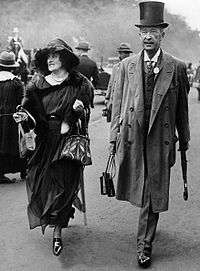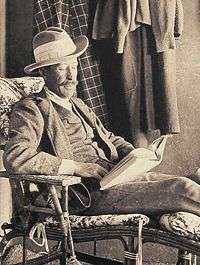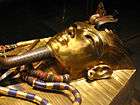George Herbert, 5th Earl of Carnarvon
| The Earl of Carnarvon | |
|---|---|
|
Lord Carnarvon, who was the chief financial backer on many of Howard Carter's Egyptian excavations. | |
| Born |
26 June 1866 Highclere Castle, Hampshire, England |
| Died |
5 April 1923 (aged 56) Cairo, Kingdom of Egypt |
| Nationality | British |
| Fields | Egyptology |
| Known for | Tutankhamun's tomb |
George Edward Stanhope Molyneux Herbert, 5th Earl of Carnarvon, DL (26 June 1866 – 5 April 1923), styled Lord Porchester until 1890, was an English aristocrat best known as the financial backer of the search for and the excavation of Tutankhamun's tomb in the Valley of the Kings.
Background and education
Styled Lord Porchester from birth, he was born at the family seat, Highclere Castle, in Hampshire, the only son of Henry Herbert, 4th Earl of Carnarvon, a distinguished Tory statesman, by his first wife Lady Evelyn Stanhope, daughter of George Stanhope, 6th Earl of Chesterfield. Aubrey Herbert was his half-brother.[1] He was educated at Eton College and Trinity College, Cambridge.[2] He inherited the Bretby Hall estate in Derbyshire from his maternal grandmother, Anne Elizabeth, Dowager Countess of Chesterfield (1802-1885), and succeeded his father in the earldom in 1890.[3]
Horse racing
Exceedingly wealthy, Carnarvon was at first best known as an owner of racehorses and a reckless driver of early cars, suffering in 1901 a serious motoring accident near Bad Schwalbach in Germany which left him significantly disabled. In 1902, he established Highclere Stud to breed thoroughbred racehorses.[4] In 1905, he was appointed one of the Stewards at the new Newbury Racecourse. His family has maintained the connection ever since. His grandson, the 7th Earl, was racing manager to Queen Elizabeth II from 1969, and one of Her Majesty's closest friends.
Egyptology
Lord Carnarvon was an enthusiastic amateur Egyptologist, undertaking in 1907 to sponsor the excavation of nobles' tombs in Deir el-Bahri (Thebes). Howard Carter joined him as his assistant in the excavations.[5] It is now established that it was Gaston Maspero, then Director of the Antiquities Department, who proposed Carter to Lord Carnarvon.[6] He received in 1914 the concession to dig in the Valley of the Kings, in replacement of Theodore Davis who had resigned. In 1922, he and Howard Carter together opened the tomb of Tutankhamun in the Valley of the Kings, exposing treasures unsurpassed in the history of archaeology.
Family

Lord Carnarvon married Almina Victoria Maria Alexandra Wombwell,[7] illegitimate daughter of millionaire banker Alfred de Rothschild,[8] at St. Margaret's Church, Westminster, on 26 June 1895. They had two children:
- Henry George Herbert, 6th Earl of Carnarvon (1898–1987), who married Anne Catherine Tredick Wendell (d.1977) and had one son, the 7th. Earl and a daughter. They divorced in 1936 and from 1939 to 1947, he was married to actress/dancer Tilly Losch.
- Lady Evelyn Leonora Almina Herbert (15 August 1901 – 1980), who married Sir Brograve Beauchamp, 2nd Baronet and had issue.[9]
Death
On 19 March 1923 Carnarvon suffered a severe mosquito bite infected by a razor cut. On 5 April, he died in the Continental-Savoy Hotel in Cairo.[10] This led to the story of the "Curse of Tutankhamun", the "Mummy's Curse". His death is most probably explained by blood poisoning (progressing to pneumonia) after accidentally shaving a mosquito bite infected with erysipelas.
Carnarvon's tomb, appropriately for an archaeologist, is located within an ancient hill fort overlooking his family seat at Beacon Hill, Burghclere, Hampshire.[11] Carnarvon was survived by his wife Almina, who remarried, and their two children.
In popular culture
Carnarvon has been portrayed several times in film, video game and television productions:[12]
- By Harry Andrews in the 1980 Columbia Pictures Television production The Curse of King Tut's Tomb.
- By Julian Curry in the 1998 IMAX documentary Mysteries of Egypt.
- By Julian Wadham in the 2005 BBC docudrama Egypt.
- By Sam Neill in the 2016 ITV series Tutankhamun.
- Evelyn Carnahan from the film The Mummy is an homage to Lord Carnarvon's daughter, Lady Evelyn.
- 'Lord Carnarvon' is the quest leader for the Archaeologist role in the classic text-based video game Nethack.
Other popular culture information:
- His country house, Highclere Castle, serves as the filming location of the ITV/PBS television series Downton Abbey, except that the below-stairs scenes were filmed on a set in London, as Highclere's basement is the home of Carnarvon's Egyptian collections. Highclere is owned by the present earl.
Ancestry
| Ancestors of George Herbert, 5th Earl of Carnarvon | ||||||||||||||||||||||||||||||||||||||||||||||||||||||||||||||||||||||||||||||||||||||||||||||||||||||||||||||||||||||||||||||||||||||||||||||||||||||||||||||||||||||||||||||||||||||||||||||||||||||||||||||||||||||||||||||||||||||||||||||||||||||||||||||||||||||||||||||||||||||||||||||||||||||||||||||||||||||||||||||||||||||||||||||||||||||||||||||||||||||||||||||||||||||||||||||||||||||||||||||||||||||||||||||||||||||||||||||||||||||||||||||||||||||||||||||||||||||||||||||||||||||||||||||||||||||||||||||||||
|---|---|---|---|---|---|---|---|---|---|---|---|---|---|---|---|---|---|---|---|---|---|---|---|---|---|---|---|---|---|---|---|---|---|---|---|---|---|---|---|---|---|---|---|---|---|---|---|---|---|---|---|---|---|---|---|---|---|---|---|---|---|---|---|---|---|---|---|---|---|---|---|---|---|---|---|---|---|---|---|---|---|---|---|---|---|---|---|---|---|---|---|---|---|---|---|---|---|---|---|---|---|---|---|---|---|---|---|---|---|---|---|---|---|---|---|---|---|---|---|---|---|---|---|---|---|---|---|---|---|---|---|---|---|---|---|---|---|---|---|---|---|---|---|---|---|---|---|---|---|---|---|---|---|---|---|---|---|---|---|---|---|---|---|---|---|---|---|---|---|---|---|---|---|---|---|---|---|---|---|---|---|---|---|---|---|---|---|---|---|---|---|---|---|---|---|---|---|---|---|---|---|---|---|---|---|---|---|---|---|---|---|---|---|---|---|---|---|---|---|---|---|---|---|---|---|---|---|---|---|---|---|---|---|---|---|---|---|---|---|---|---|---|---|---|---|---|---|---|---|---|---|---|---|---|---|---|---|---|---|---|---|---|---|---|---|---|---|---|---|---|---|---|---|---|---|---|---|---|---|---|---|---|---|---|---|---|---|---|---|---|---|---|---|---|---|---|---|---|---|---|---|---|---|---|---|---|---|---|---|---|---|---|---|---|---|---|---|---|---|---|---|---|---|---|---|---|---|---|---|---|---|---|---|---|---|---|---|---|---|---|---|---|---|---|---|---|---|---|---|---|---|---|---|---|---|---|---|---|---|---|---|---|---|---|---|---|---|---|---|---|---|---|---|---|---|---|---|---|---|---|---|---|---|---|---|---|---|---|---|---|---|---|---|---|---|---|---|---|---|---|---|---|---|---|---|---|---|---|---|---|---|---|---|---|---|---|---|---|---|---|---|---|---|---|---|---|---|---|---|---|---|---|---|---|---|---|---|---|---|---|---|---|---|---|---|---|---|---|---|---|---|---|---|---|---|---|---|---|---|---|---|---|---|---|---|---|---|---|---|---|---|---|---|---|---|---|---|---|---|---|---|---|---|---|---|---|---|---|---|---|---|---|---|---|---|---|---|---|---|---|---|---|---|---|---|---|---|---|---|---|---|---|---|---|
| ||||||||||||||||||||||||||||||||||||||||||||||||||||||||||||||||||||||||||||||||||||||||||||||||||||||||||||||||||||||||||||||||||||||||||||||||||||||||||||||||||||||||||||||||||||||||||||||||||||||||||||||||||||||||||||||||||||||||||||||||||||||||||||||||||||||||||||||||||||||||||||||||||||||||||||||||||||||||||||||||||||||||||||||||||||||||||||||||||||||||||||||||||||||||||||||||||||||||||||||||||||||||||||||||||||||||||||||||||||||||||||||||||||||||||||||||||||||||||||||||||||||||||||||||||||||||||||||||||
Works
- Earl of Carnarvon; et al. (1912). Five years' explorations at Thebes: a record of work done 1907-1911. London: Henry Frowde.
References
- ↑ thepeerage.com George Edward Stanhope Molyneux Herbert, 5th Earl of Carnarvon
- ↑ "Herbert, George Edward Stanhope Molyneux, Lord Porchester (HRBT886GE)". A Cambridge Alumni Database. University of Cambridge.
- ↑ Zoehfeld, Kathleen Weidner; Nelson, James (2007). "3". The Curse of King Tut's Mummy. Random House Books for Young Readers. ISBN 978-0-375-83862-0.
- ↑ "Architecture". House and Garden. Condé Nast Publications, Ltd. 160 (1-4): 54. 1994.
- ↑ Winstone, H. V. F. (2006). Howard Carter and the discovery of the tomb of Tutankhamun (rev. ed.). Manchester: Barzan. ISBN 1-905521-04-9.
- ↑ A letter of Maspero dated 14 October 1907, contained in his archives in the library of the Institut de France says: You have been kind enough to say to me that you could find a man who knows Egyptology to survey my works. Have you thought to anybody? I will leave the question of payment in your hands but I think I would prefer a compatriot (Manuscripts 4009, folios 292-293). On 16 January 1909, Carter writes to Maspero: Just a word to tell you that Lord Carnarvon has accepted my conditions. He will be there (in Egypt) from 12 February to 20 March. I have to thank you again... (Manuscripts 4009, folio 527) - from Elisabeth David.
- ↑ Barnard Burke, 1914, p.387
- ↑ Seymour, Miranda (15 September 2011). "Lady Almina and the Real Downton Abbey by Fiona Carnarvon – review". The Guardian.
- 1 2 Charles Mosley, editor, Burke's Peerage, Baronetage & Knightage, 107th edition, 3 volumes (Wilmington, Delaware, U.S.A.: Burke's Peerage (Genealogical Books) Ltd, 2003).
- ↑ "Carnarvon Is Dead Of An Insect's Bite At Pharaoh's Tomb. Blood Poisoning and Ensuing Pneumonia Conquer Tut-ankh-Amen Discoverer in Egypt.". New York Times. 5 April 1923. Retrieved 12 August 2008.
The Earl of Carnarvon died peacefully at 2 o'clock this morning. He was conscious almost to the end.
- ↑ Carnarvon's Tomb
- ↑ "Carnarvon (Character)". IMDb.com. Retrieved 8 May 2008.
Further reading
- with Howard Carter, Five Years' Explorations at Thebes - A Record of Work Done 1907-1911, ed. Paul Kegan, 2004 (ISBN 0-7103-0835-3).
- Five Years' Explorations at Thebes
- Fiona Carnarvon, Egypt at Highclere - The discovery of Tutankhamun, Highclere Enterprises LPP, 2009.
- Fiona Carnarvon, Carnarvon & Carter - the story of the two Englishman who discovered the tomb of Tutankhamun, Highclere Enterprises LPP, 2007.
- Elisabeth David, Gaston Maspero 1846-1916, Pygmalion/Gérard Watelet, 1999 (ISBN 2-85704-565-4).
- Cross William, Carnarvon, Carter and Tutankhamun Revisited. The hidden truths and doomed relationships, Book Midden Publishing, 2016 (ISBN 978-1905914-36-4).
- Cross William, Lordy! Tutankhamun's Patron As A Young Man , Book Midden Publishing, 2012 (ISBN 978-1-905914-05-0).
- Cross William, The Life and Secrets of Almina Carnarvon : 5th Countess of Carnarvon of Tutankhamun Fame , 3rd Ed 2011 ( ISBN 978-1-905914-08-1).
- Cross William, Catherine and Tilly: Porchey Carnarvon's Two Duped Wives: The Tragic Tales of the Sixth Countesses of Carnarvon, Book Midden Publishing, 2013 ( ISBN 978-1905914-25-8).
External links
- Works by Carnarvon at Project Gutenberg
- Hansard 1803–2005: contributions in Parliament by the Earl of Carnarvon
- George Herbert, 5th Earl of Carnarvon Bio at Highclere Castle
- Highclere Castle, home of the 5th Earl
| Peerage of Great Britain | ||
|---|---|---|
| Preceded by Henry Herbert |
Earl of Carnarvon 1890–1923 |
Succeeded by Henry Herbert |

